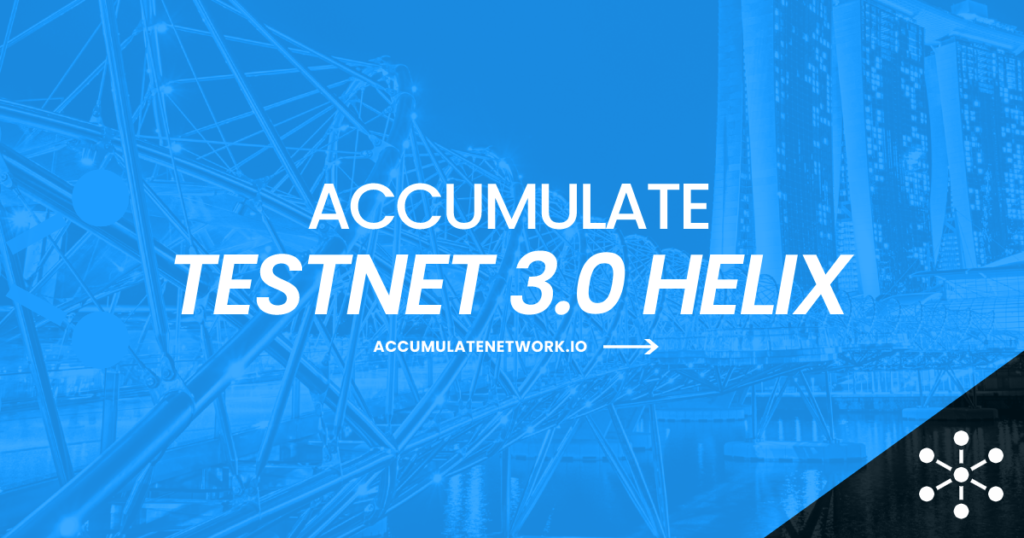
With article contributions from Drew Mailen
Today is the official launch of the Accumulate Testnet 3.0 Helix, named after the landmark pedestrian Helix Bridge that connects Singapore’s Marina Centre and Marina South.
The Testnet 3.0 Helix release notes significant improvements in the following areas:
- Protocol
- Command Line Interface (CLI)
- Explorer
- Software Development Kits (SDKs)
- Mobile App
- Ledger Hardware Wallet Development
- Technical Documents
Rooted in identity and key management, Accumulate is a universal interconnect protocol that’s interoperable across Web 2 and Web 3 addresses from layer 1 blockchains to enterprise tech stacks, to websites.
Protocol
- Anchoring: Anchors represent the state of a particular chain, BVN, or DN up to a certain point in time. Anchors are necessary for cryptographically proving transactions.
- Transaction Batching: The ability for transactions to be batched must exist, such that a set of transactions is processed in a specific order. Synthetic transactions sent between BVNs must be batched.
- Validator Onboarding: To secure the Accumulate, validators are needed to verify transactions. Accumulate can begin to onboard external parties to participate in validation.
- Fee Schedule: Every action in Accumulate requires Credits. The Accumulate fee schedule outlines credits required per each action.
- Burning Tokens: ACME Tokens that are burned when purchasing credits will be added to the uncirculated supply.
- API Changes to V0.2: See changes here.
Command Line Interface
- Multi-sig: Individuals or enterprises can construct sophisticated Multi-sig transactions. Multi-sig transactions are specified by m of n keys required within a Key Page.
- ADI Scratch Accounts: An ADI scratch account can write data to the blockchain that is pruned over a certain period of time (roughly 2 weeks). In Accumulate there are ADI Scratch Data Accounts and ADI Scratch Token Accounts. Because the Data is pruned, Scratch Data and Token transactions are cheaper.
- Scratch Spaces: This is a transient blockchain (data is stored for 2-3 weeks) with fast block times that allows different parties to reach a consensus off-chain (e.g. they are negotiating the terms of a deal and developing a multi-signature smart contract). Scratch Spaces are good for privacy because a user may not want to broadcast their decision-making process to the main blockchain. Scratch Spaces reduces cost because a user posts the conclusion, not the work. Instead of a dozen transactions (the work), you post 1 transaction (the conclusion).
- Token Issuer: Custom tokens can be created on Accumulate.
- Lite Data Chain: A data chain that anyone can hash data to.
- Credits: In order to execute a transaction, credits must be funded in the lite token account or ADI Key Page. Credits are acquired through burning ACME tokens.
- QR Codes: QR codes can be used to receive transactions.
Explorer
- Key Book and Key Page: Key Books and Key Pages can be viewed by URL instead of ChainID.
- ADI Data Accounts: ADI Data Accounts can be displayed with their entry info, external IDs, and Data.
- Lite Data Account: Lite Data Accounts can be displayed with their entry info, external IDs, and Data.
- ADI Scratch Data Account: ADI Scratch Data Accounts can be displayed with their entry info, external IDs, and Data. A scratch data account will be identified by a pop-up above the Account URL.
- ADI Scratch Token Account: ADI Scratch Token Accounts can be displayed with their entry info, external IDs, and Data. A scratch token account will be identified by a pop-up above the Account URL.
Web App
The first version of the UI has been created for Accumulate’s Web App. There will be a series of releases where the Web App will have all the features of the mobile app plus additional features.
Software Developer Kits (SDKs)
- Accumulate.js – Javascript SDK Beta Version
- Golang SDK Beta Version
Ledger Hardware Wallet
ACME compatibility with the Ledger Hardware wallet is in progress now with the below updates.
- Ledger Hardware Integration
- Ledger Toolchain
- Firmware Update
- Debug Test Environment Setup
Mobile App
- Transaction Receive Token Dropdown: The top drop menu here is to allow the user to choose either a lite account or Token Account so if they have already light account selected, the drop menu should just show token account, and vice versa.
- Transaction Token Address book workflow: the address book icon should be linked to the address book workflow so users can access the address book to populate the manual field.
- The App now gives you an error if you have insufficient funds to cover a transactionKey page screen shows the credit balance for each key page in an ADIMobile app now lists the credit fee for each transaction type a user can do.
- Transaction History Section: Fix faucet transactions so they show in the “incoming” section of the transaction history.
- History filter: The ability to filter transaction history by transaction type, receiving account, sending account, etc.
- Notifications: The app will now send push notifications to the user for things like a successful transaction.
- Setting Section: Additional upgrades to the Address Book settings.
- Dashboard Improvements: There will now be a Dashboard that the user can see all the information on their account from, including details about the user’s ADIs and ADI accounts, and Lite accounts.
- Additional Improvements:
- Layout Enhancements for better user experience
- App Responsiveness & Bug Fixes for better user experience
0 Comments